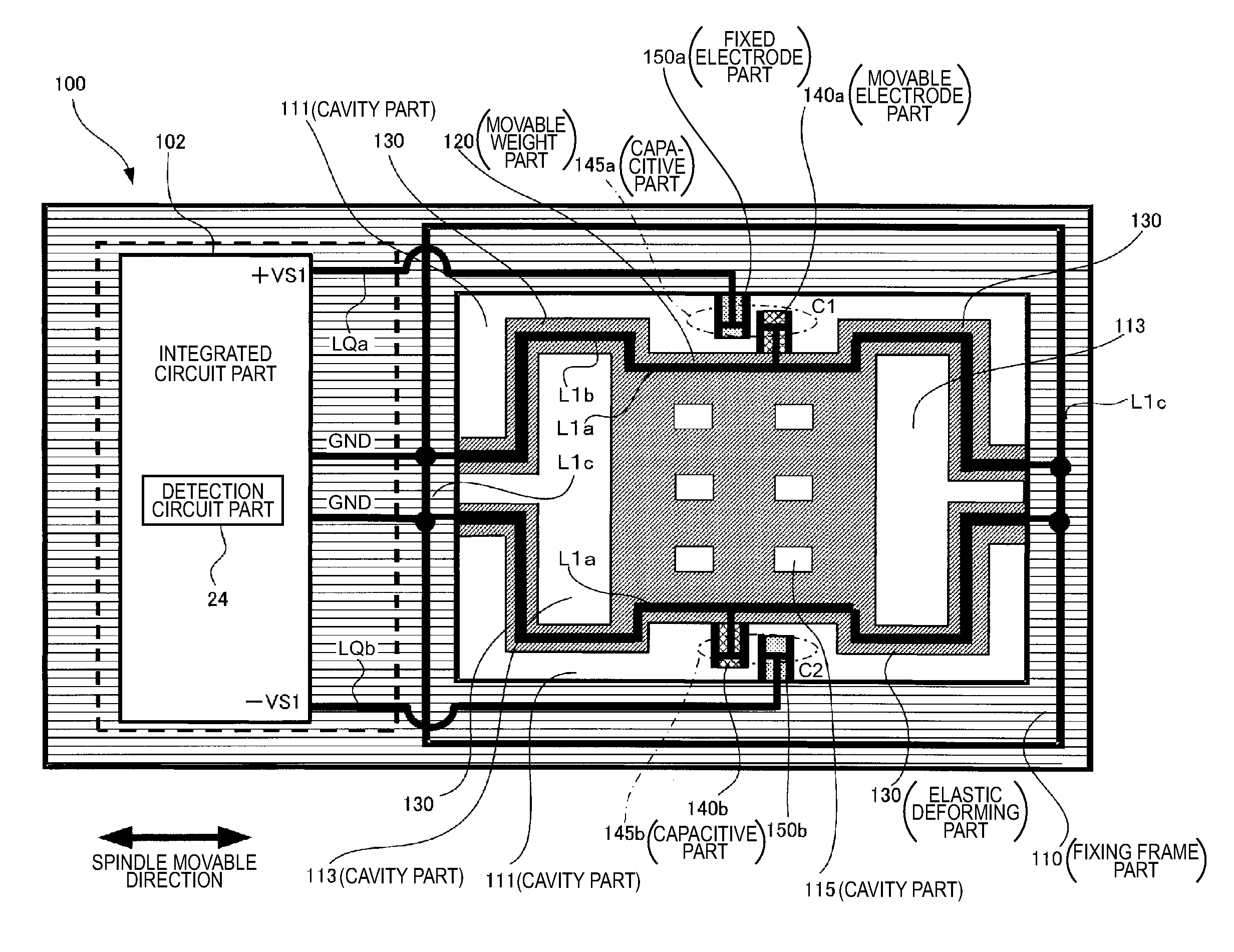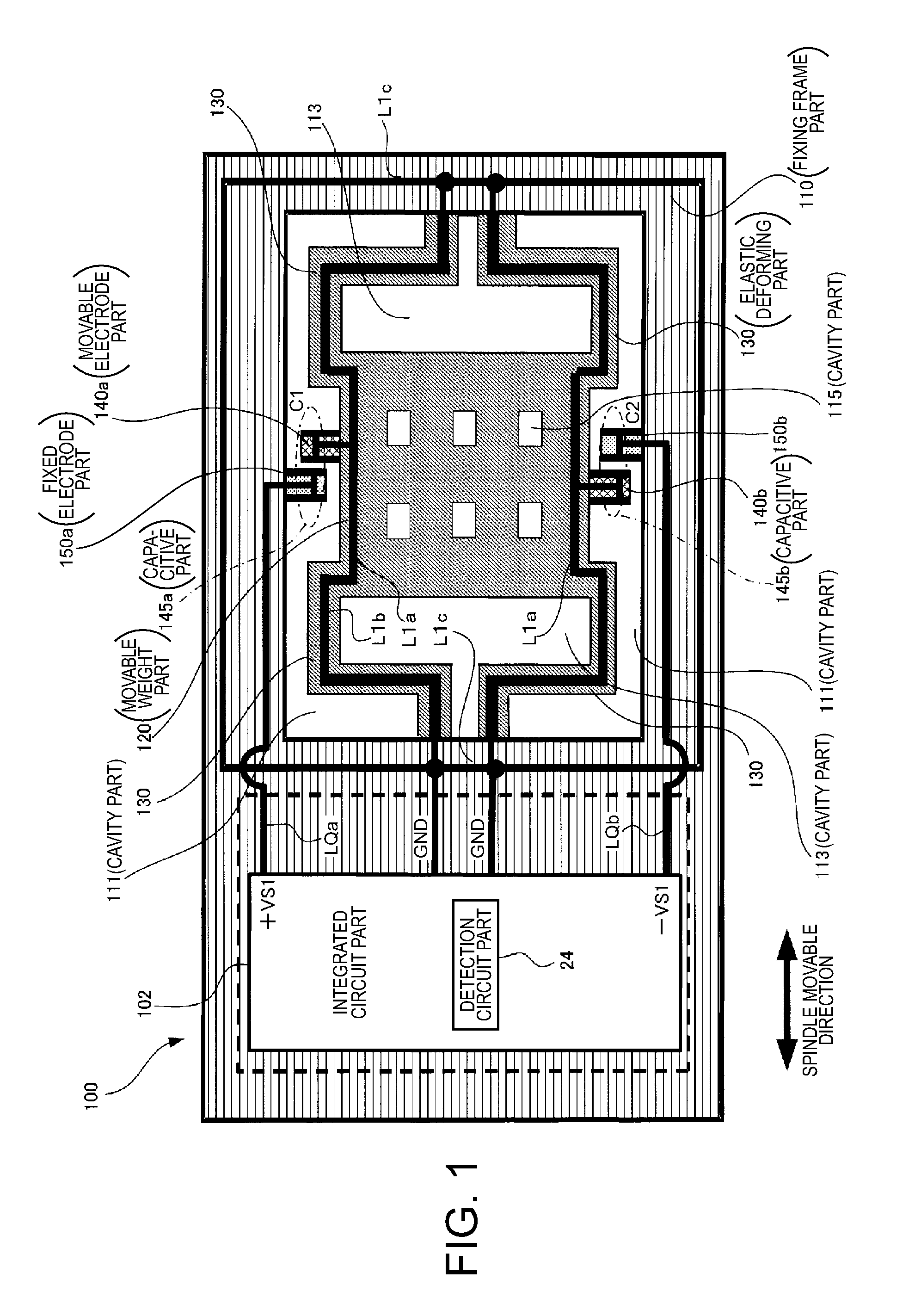Physical quantity sensor, manufacturing method of physical quantity sensor, and electronic apparatus
a manufacturing method and sensor technology, applied in the direction of speed/acceleration/shock measurement, flexible microstructure devices, instruments, etc., can solve the problems of difficult substrate use, complex manufacturing process of mems sensor, and inability to secure a path for providing direct-current bias or a path for taking out detection signals between capacitive electrodes only by, so as to reduce the cost of physical quantity sensors and provide physical quantity sensors relatively easily
- Summary
- Abstract
- Description
- Claims
- Application Information
AI Technical Summary
Benefits of technology
Problems solved by technology
Method used
Image
Examples
first embodiment
[0092]First, one configuration example of an MEMS sensor as a physical quantity sensor will be explained.
Overall Configuration of Capacitive Acceleration Sensor
[0093]FIG. 1 is a plan view showing a configuration of an example of the MEMS sensor as a physical quantity sensor (here, a capacitive acceleration sensor) of an aspect of the invention. In the drawing, wires and electrodes formed by conducting materials are shown by thick solid lines.
[0094]In FIG. 1, a capacitive acceleration sensor 100 may be manufactured by forming a laminated structure on a substrate and selectively processing the laminated structure and the substrate using a semiconductor manufacturing technology. For example, after the laminated structure is formed on the substrate, the laminated structure is selectively patterned using anisotropic dry etching, for example, to form cavity parts 111, 113, 115, and further, an etchant for isotropic etching is allowed to reach the substrate surface via the cavity parts 111...
first example
[0115]FIGS. 3A to 3F are diagrams (sectional views of a device) for explanation of an outline of a basic manufacturing process (first example) of an MEMS sensor like the capacitive acceleration sensor 100 shown in FIGS. 1 and 2.
[0116]At the first step shown in FIG. 3A, the laminated structure ISX in which the insulating layers, at least one conductor layer QL (for example, the conductor layer to be the first connecting conductor layers L4a, L4b as the first connection electrode part, the second connecting conductor layers L5a, L5b as the second connection electrode part, the lead wires L2a, L2b, L3a, L3b, etc.) are formed is formed on the substrate BS.
[0117]At the second step shown in FIG. 3B, the laminated structure ISX formed on the substrate BS is patterned by anisotropic etching and a first cavity part Opa (specifically, the first cavity parts 111a, 113a, 115a) is formed. The at least one conductor layer QL is patterned, and thereby, the first connecting conductor layers L4a, L4...
second example
[0124]FIGS. 19A to 21C are sectional views of a device with respect to each step for explanation of an outline of a manufacturing method (second example) of the capacitive acceleration sensor 100 shown in FIGS. 1 and 2.
[0125]In the manufacturing method of the capacitive acceleration sensor 100 shown in FIGS. 19A to 21C, when the fixed electrode (the first side surface conductor CQ1) is formed in the fixed electrode part 150 and the movable electrode (second side surface conductor CQ2) is formed in the movable electrode part 140, a method of securing electric conduction via contact conductors (connecting conductors) formed to cover the bottom surfaces and the inner wall surfaces of contact holes is employed.
[0126]That is, at the first step shown in FIG. 19A, a conductor layer as the first connecting electrode part (first internal conductor: here, referred to as “LX1” for convenience of explanation) is embedded in the laminated structure ISX. The end of the first internal conductor LX...
PUM
 Login to View More
Login to View More Abstract
Description
Claims
Application Information
 Login to View More
Login to View More - R&D
- Intellectual Property
- Life Sciences
- Materials
- Tech Scout
- Unparalleled Data Quality
- Higher Quality Content
- 60% Fewer Hallucinations
Browse by: Latest US Patents, China's latest patents, Technical Efficacy Thesaurus, Application Domain, Technology Topic, Popular Technical Reports.
© 2025 PatSnap. All rights reserved.Legal|Privacy policy|Modern Slavery Act Transparency Statement|Sitemap|About US| Contact US: help@patsnap.com



